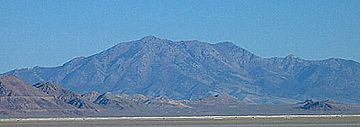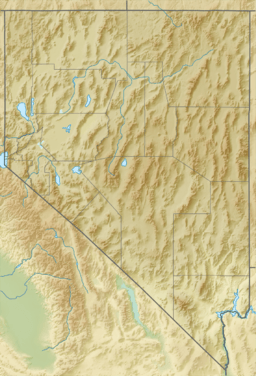Pilot Range facts for kids
Quick facts for kids Pilot Range |
|
|---|---|

Pilot Peak
|
|
| Highest point | |
| Peak | Pilot Peak |
| Elevation | 10,716 ft (3,266 m) |
| Dimensions | |
| Length | 30 mi (48 km) SSW to NNE |
| Width | 4 mi (6.4 km) |
| Area | 80 sq mi (210 km2) |
| Geography | |
| Country | United States |
The Pilot Range is a group of mountains found right on the border between Utah and Nevada in the United States. It's about 50 miles west of the famous Great Salt Lake. This mountain range helps form the northwest edge of the Great Salt Lake Desert.
The highest point in the Pilot Range is Pilot Peak, which stands tall at 10,716 feet. Most of these mountains are public land, managed by the Bureau of Land Management. This means people can visit them freely! The main activities here include mining, allowing livestock to graze, and hunting for elk and deer during certain seasons.
Exploring the Pilot Range
The Pilot Range starts about 15 miles north of a town called West Wendover. From there, it stretches north-northeast for about 30 miles. An old railroad town named Lucin, Utah used to be just two miles northeast of the range.
The mountains run from the southwest to the northeast. Many canyons branch off the main ridgeline, heading east and west. The whole area covers about 51,200 acres. The height of the land changes a lot, from about 5,000 feet at the base to the towering 10,716-foot Pilot Peak. Other important summits (or peaks) in the range include Copper Mountain, Bald Eagle Mountain, and Rhyolite Butte.
To the east of the Pilot Range, you'll find the Pilot Valley Playa and its springs. Beyond that are the Silver Island Mountains. To the west is the northern part of Pilot Creek Valley.
Plants and Animals of the Pilot Range
You can find several springs, both fresh and salty, flowing from the base of the mountains. These springs come from the alluvial fans, which are fan-shaped deposits of sediment. The biggest spring is Bettridge Creek. This creek is a special habitat for a fish called the Lahontan cutthroat trout, which is a threatened species.
The plants you see in the Pilot Range change depending on how high up you go. At the very top, you'll find trees like Engelmann Spruce and Limber Pine. In the middle parts of the mountains, there are pinyon pine, mountain mahogany, and juniper trees.
On the sunny, south-facing slopes and ridge-tops, you'll mostly see sagebrush and grass. In the lower areas, there's rabbitbrush, more grass, and greasewood. A very rare plant called the Pilot Range cinquefoil (Potentilla cottamii) grows only in the Pilot Range and a few other nearby mountain ranges.


